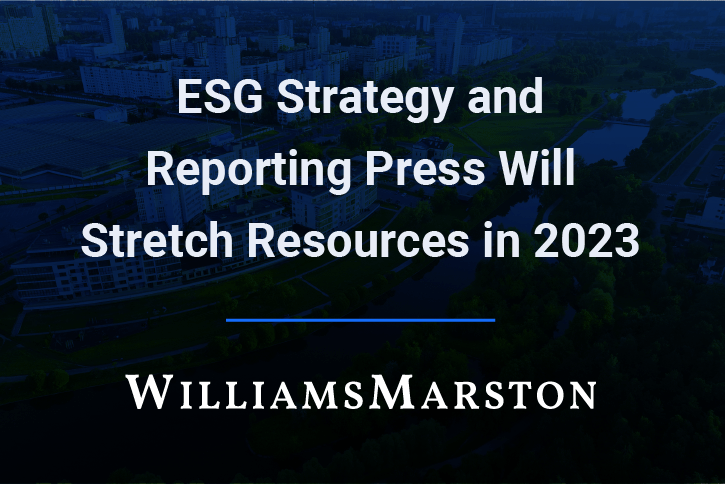ESG Strategy and Reporting Press Will Stretch Resources in 2023

Regulatory and stakeholder pressure around ESG strategy and reporting will continue to stretch internal resources in 2023.
As global regulators and a more engaged class of stakeholders demand action around organizations’ environmental, social and governance (“ESG”) work, it has become imperative for public and private equity-backed companies to advance the quality of their ESG reporting. Forward-looking management teams are re-examining their level of participation in this evolving landscape and actively operationalizing numerous ESG and sustainability initiatives. Many are seeking outside help.
Their rationale is clear. Public companies will soon be subject to climate disclosure reporting requirements, both domestically and internationally. Private companies are increasingly seeing their current/prospective customers, lenders, institutional investors, vendors, and regulators demand quality ESG data. Failure to provide such information could impact their access to capital, cost of financing and their competitive advantage in the market.
With the finalization of proposed regulatory reporting requirements on the horizon, companies would be wise to act now. But beyond the impact-driven work advancing, they’ll need to update their operations, processes, systems and controls to ensure they can report highly accurate and comparable data.
To assist in navigating ESG implementation, WM leverages its top-rated accounting advisory, tax, and valuation professionals to provide a holistic ESG solution for you, our client. Partnering with leading environmental, health and safety experts, WM will assist in establishing a data and control infrastructure, tailored specifically to address all of your ESG regulatory and reporting needs.
Act now!
Reach out and let’s discuss how your company will be impacted by the changing regulatory and reporting environment and how WM can help you best prepare.

What You Can Do Now to Prepare
1. Establish a governance framework
No one person should be in charge of a company’s ESG program. Rather, organizations should ensure a proper governance framework is in place – a process that requires cooperation and commitment. As a first step, companies can assemble an interdisciplinary ESG task force or steering committee with senior C-suite-level sponsorship and representatives from finance, accounting, legal, and operations. This organizational body should commit to regular, ongoing meetings to discuss the ever-changing ESG landscape, better allowing the company to do more than just comply with industry standards, but take full advantage of ESG opportunities.
2. Educate management and the Board of Directors
It is important that management and the Board of Directors have adequate knowledge of ESG regulations, risks, and opportunities to direct implementation efforts, ensure company compliance, and to evaluate opportunities for competitive advantage. Efforts should be made to ensure appropriate trainings are available for those in leadership positions.
3. Identify impacts
ESG impacts every company differently. When evaluating impacts, start small – determine what story your company wants to tell the market. Utilize industry-specific standards to understand key performance indicators material to your stakeholders.
4. Build an adaptable ESG infrastructure
Focus on building an ESG strategy that can shift along with evolving pressures from global regulators, lenders, investors, consumers and employees, and supply chain partners. It should also seek to address more than just one goal – for example, it can drive compliance, address stakeholder needs, mitigate risks and exploit opportunities. Companies that perform a thorough short-term and long-term risk assessment are more likely to succeed in building this adaptable ESG infrastructure.
5. Integrate ESG into everyday business operations
Integration of ESG risks and opportunities into the strategic planning and enterprise risk management processes is key to appropriately assessing material risks and opportunities impacting the company. Integrating ESG considerations into financing and operational decisions will also become increasingly important in today’s environment that prioritizes sustainability and good corporate citizenship.
It is important to remember that ESG is more than a compliance exercise. It is an opportunity to build value, mitigate risk, and drive competitive advantages.